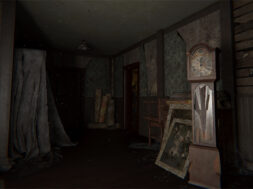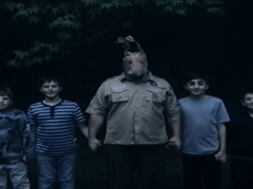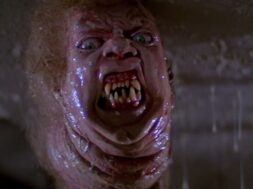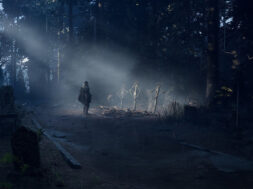
Riding high after the phenomenal success of 1997’s Final Fantasy VII, Squaresoft decided to be a little ambitious. Its next projects not only included branching out into other genres with their impressive shoot-’em-up Einhänder, but also seeing how far it could go with its tried-and-true genre, the RPG. Enter Parasite Eve. Blending a mix of real-time combat and traditional role-playing mechanics, the game ended up being a hit for Square, though has sadly been forgotten. On the 20th anniversary of the game’s release (in Japan), it’s worth looking back on how the game wasn’t just another Final Fantasy, but also how it was part of the J-Horror phenomenon of the late 90s.
Before actually getting into the game, it’s worth noting that Parasite Eve the game is actually a sequel. A sequel to Hideaki Sena’s 1995 novel of the same name, to be exact. Sena’s background in pharmacology, combined with his day job in microbiology, as well as a television documentary that he had watched, inspired him to write “Parasite Eve”. The story for the novel revolves around symbiogenesis, a theory that mitochondria (aka the powerhouse of biological cells) were originally a separate organism unto themselves, but lived in a symbiotic relationship within the cells of another organism. Sena’s novel concerns the idea of “What if the mitochondria are actually a sentient lifeform?,” and the resultant chaos that occurs when the mitochondria decide to take over their hosts on their way to taking over the world.

The novel became the first winner of the Japan Horror Novel Award, and with Koji Suzuki’s “Ringu”, spawned film adaptations and mangas, and in the case of “Ringu”, started the ball rolling with American remakes of Japanese horror films in the late 90s-early 2000s.
As for the game, thankfully it’s not necessary to have read the book (which is good, since the novel wasn’t translated into English until 2005). The plot centres on New York City police officer Aya Brea over a six-day span in 1997. On Christmas Eve, Aya attends an opera at Carnegie Hall, where during the aria of the diva, Melissa Pearce, people start to spontaneously combust. Aya and Melissa are the only ones left, with Melissa soon mutating into a creature and escaping into the sewers. Later on, it’s revealed that Melissa (now calling herself “Eve”) is the living embodiment of the mitochondria, and can control other people’s mitochondria. Aya must now find a way to stop Eve from destroying New York City, but also the world. The premise is both cool and ridiculous at the same time, but isn’t what you’d call a standout. It’s your basic “save the world” scenario, with the mitochondria situation being explained to the player in Grade 10 biology terms. While the story isn’t anything to fawn over, the characters do pack a lot of emotion into the dialogue, and the plot twists and eventual over-the-top climax do manage to keep you engaged in some form.

What set Parasite Eve apart from Square’s previous RPGs was the combat. Like Final Fantasy, players engaged in random battles. However, upon entering a battle, instead of it being turn-based, Parasite Eve uses a real-time combat system with an Active Time Bar (ATB) that sets the time that a player must wait until they can take their next action. During this wait, the player can move Aya around the area to dodge enemy attacks, or find a safe place to mount an attack of their own. When the ATB is full, the player may choose to escape, use an item, attack with their equipped weapon, or in place of magic, use Aya’s PE (Parasite Energy) for an attack/defense “spell”. If you choose to attack, the battle momentarily pauses, and a dome/sphere appears to indicate the range of the weapon, allowing the player to target an enemy within range until the rounds in Aya’s gun have been spent. This also puts Aya in a vulnerable position, as she’s unable to move until she finishes firing, making the player think carefully about their attack position. This combat system was later modified and reused two years later in another of Square’s forgotten games in Vagrant Story.

As far as weapons go, there are no shortage of guns in the game, ranging from pistols and shotguns to machine guns and grenade launchers. Each weapon has varying properties (range, clip size, rate of fire, etc.), and both weapons and armour have common RPG battle system properties, allowing the player to have things such as the ability to have the first attack in the battle, add ice or poison effects to your weapon, and so on. The game also has an equipment mod system in which weapons and armour can be broken down and their modifiers transferred to other items. Again, this premise was used in Vagrant Story years later.

Graphically, the game obviously looks dated, but it’s not outright laughable, either. The character models are more detailed than they were in FFVII, and New York has been recreated (and in some places, reinterpreted) to the best of 1998 abilities. And it’s not too shabby. The environments all reflect a certain cinematic quality in them. Even the camera angles are reminiscent of the ones found in Resident Evil. Speaking of “cinematic”, the cinematic when you start the game is definitely one that will grab your attention even today. This is definitely a game for body horror fans. Another cinematic where the audience hearing Melissa’s aria spontaneously melt certainly proves that. Granted, some of the cinematics do appear a bit rough today, but Square’s mastery of CGI back then still gives the cinematics a boost.
Musically, the score by Yoko Shimomura (who also did the immortal Street Fighter II soundtrack) is excellent. Mixing opera and electronica, Parasite Eve‘s music is quite engaging. It’s certainly not what you’d hear from Squaresoft’s go-to composers, which is refreshing. So much so that Shimomura’s work on Parasite Eve landed her the job of scoring other big-name Square games, most notably the first two Kingdom Hearts games.

If there was anything negative to say about Parasite Eve, then or now, is its linear progression and its length. You can finish the game in about 12 hours, and you’ll spend about as much game time watching characters talking as you will be exploring Manhattan and fighting battles. Compared to FFVII‘s 40 hours and its expansive world, this is definitely short. There’s the New Game+ option where Aya starts out equipped with the gear she had at the game’s end, and this also unlocks the Chrysler Building. The Chrysler Building consists of 77 floors of randomly-generated maps, bosses at regular intervals, and increasingly stronger monsters. At the top is an optional end boss, which after defeating it gives you an alternate ending. It’s one of those “nice that they included it” things, but it all just feels like busywork, especially when the game could’ve been so much longer.
Parasite Eve was released to favourable reviews, with attention paid to the graphics and cinematics. The game ended up selling 1.9 million copies overall, with most of them being sold in Japan. It was good enough to warrant a Greatest Hits re-release here in North America. Eventually, the game received a sequel in 2000, but the game mechanics were changed to focus less on the RPG elements, and more on the action and survival horror themes. These days, you can grab a complete copy of Parasite Eve on eBay for around $30 USD, or if you want the emulated version, it’s available on the PlayStation Store for the PS3 (for NTSC regions only, sadly).

The game was definitely a break in the mould for Squaresoft, who sadly don’t seem to be interested in revisiting the series. Despite the short amount of gameplay and its relatively linear progression, the game certainly deserves recognition for being different, but also for being just as fun as any of Square’s other RPGs. It’s also a must for those into survival horror and body horror. Give it a shot if you missed it the first time.










